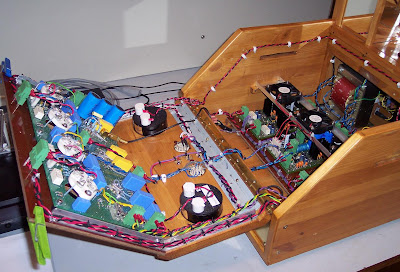Parallel Push-Pull 300B Mono Amplifiers
Rudolf Moers from the Netherlands has kindly sent us details of his parallel push-pull 300B monoblock tube amplifiers to share with the DIY Audio community. It should be quite obvious from the photographs that the design and construction of a pair of amplifiers this size is by no means a small undertaking. Rudolf tells us that he spent about 14 months designing and constructing the pair of monoblock amplifiers. The total cost of each amplifiers was about 1300 Euro, or about $1760US as of 29 September 2010. Each monoblock weighs 25 kg (55 pounds) and the overall dimensions are 530 mm deep, 390 mm high, 400 mm wide.
 |
Parallel Push-Pull 300B Mono Amplifiers |
Schematics - Parallel Push-Pull 300B Tube Amplifier
The few notes on the schematics are written in Dutch. You can use a free online language translation service like Google Translate to translate them into English.
- Parallel push-pull 300B vacuum tube amplifier Schematic - [PDF - 270 kB]
- Parallel push-pull 300B vacuum tube amplifier Block Diagram - [PDF - 43 kB]
Parallel Push-Pull 300B Tube Amplifier
The input stages consists of a preamplifier and cathode phase splitter using a ECC82 (12AU7), amplitude amplification (driver) using a ECC99 and cathode followers using a ECC82 (12AU7) tube. The output stage uses four 300B directly heated power triodes in a parallel push-pull configuration (Ia = 40mA and Vak = 356 VDC) with no negative feedback. The output power for each monoblock is about 25W.
When powered on the heater supply for the ECC[82,99,82] tubes goes from 1.5 to 6.3 VDC in 30 seconds. Likewise, the 300B heater supply goes from 1.5 to 5.0 VDC in 30 seconds. Polarity of 5.0 VDC heater supply can be reversed with a switch. All the heater voltages are separated using galvanic isolation.
The high voltage supply uses a mercury filled full-wave rectifier AX50 and is switched on when all heater voltage are at about 90% of their final value. The AX50 rectifier limits the maximum output power to 25W.
The high voltage supply uses a mercury filled full-wave rectifier AX50 and is switched on when all heater voltage are at about 90% of their final value. The AX50 rectifier limits the maximum output power to 25W.
The enclosure is wooden and easily accessible with a hinged lid and there is plenty of interior space. The amplifier is constructed in a completely modular fashion with connectors. All the modules are built on prototyping boards.
Measurements Parallel Push-Pull 300B Tube Amplifier
Input power: 281 W(RMS) at 230V (50Hz/60Hz) mains voltageOutput power: 25 W(RMS) at 0 dB (775 mV) sine wave input signal
Efficiency: 8%
Bandwidth:
-0.1 dB at 20 Hz and 50 kHz at 25 W
-3.0 dB at 10 Hz and 100 kHz at 25 W
Distortion (THD) (distortion without hum suppression)
1.5% at 5 W and 10 Hz
4.0% at 23 W and 20 Hz
3.5% at 25 W and 50 Hz
3.5% at 25 W and 100 Hz
3.5% at 25 W and 200 Hz
3.4% at 25 W and 500 Hz
3.5% at 25 W and 1 kHz
3.5% at 25 W and 2 kHz
3.5% at 25 W and 5 kHz
3.5% at 25 W and 10 kHz
3.3% at 25 W and 20 kHz
2.7% at 25 W and 50 kHz
4.4% at 15 W and 100 kHz
THD < 1% at 2 W between 10 Hz and 20 kHz
THD < 2% at 10 W between 10 Hz and 20 kHz
THD < 3% at 15 W between 10 Hz and 20 kHz
Hum voltage over the loudspeaker is < -51 dB and inaudible with an ear against the loudspeaker.
Rudolf informs us that the design of this parallel push-pull 300B tube amplifier is explained in his new book "Fundamentele versterkertechniek met elektronenbuizen", ISBN 978-90-5381-226-6 which is currently only available in Dutch. However, an English translation "Fundamental Amplifier Techniques with Electron Tubes" is expected in November 2010. We will post an update when the English version is available.
UPDATE (2010-11-15) - the English translation Fundamental Amplifier Techniques with Electron Tubes is now available.
More 300B Triode Amplifiers
- 6SN7 / 300B Single-Ended Tube Amplifier Schematic
- 6SN7 / 300B SET Amplifier Build Thread
- DIY 300B Single-Ended-Triode (SET) Hi-Fi Amplifier Project



Very beautiful power amplifier. What about the small tube amplifier at the bottom of the photograph?
ReplyDeleteThank you
Beautiful piece of work! A little over designed for my tastes, but beautiful none the less.
ReplyDeleteWOW!
PERFECT!!!!!!!!!!!!!
ReplyDeleteCONGRATULATIONS
Wow, simply amazing! Very Beautiful!
ReplyDeletethanx 4 keeping tubes alive
ReplyDeletetube electronics -- the only nuke proof radio concept!
ReplyDeleteCONGRATS, What a piece of work !!!! I can definitely see just where all the time and money went. Can well appreciate the work even though I would never go that far. The dedication to keep going just to finish and to such a hign standard, nothing out of place..... Love the clothes pegs..... smile, smile, smile.... Just had to do that for a laugh.... Love to see more of your work... Keep well and greetings from Christchurch, New Zealand.
ReplyDeletecomplimenti gran bel lavoro tubi tutta la vita!!!!!
ReplyDeleteit is beautiful,BUT!!
ReplyDeleteDon't you think it need better ventilation!!!,special in transformers compartment, that little PC fans,!!!I WOULDN'T PUT IT NEAR ANY TUBE ELECTRONIC,with better ventilation,no induction from nasty little fans!!!
Tunnel vision,usually left us with many holes in the way we walk,!! cheers
Outstanding!
ReplyDelete